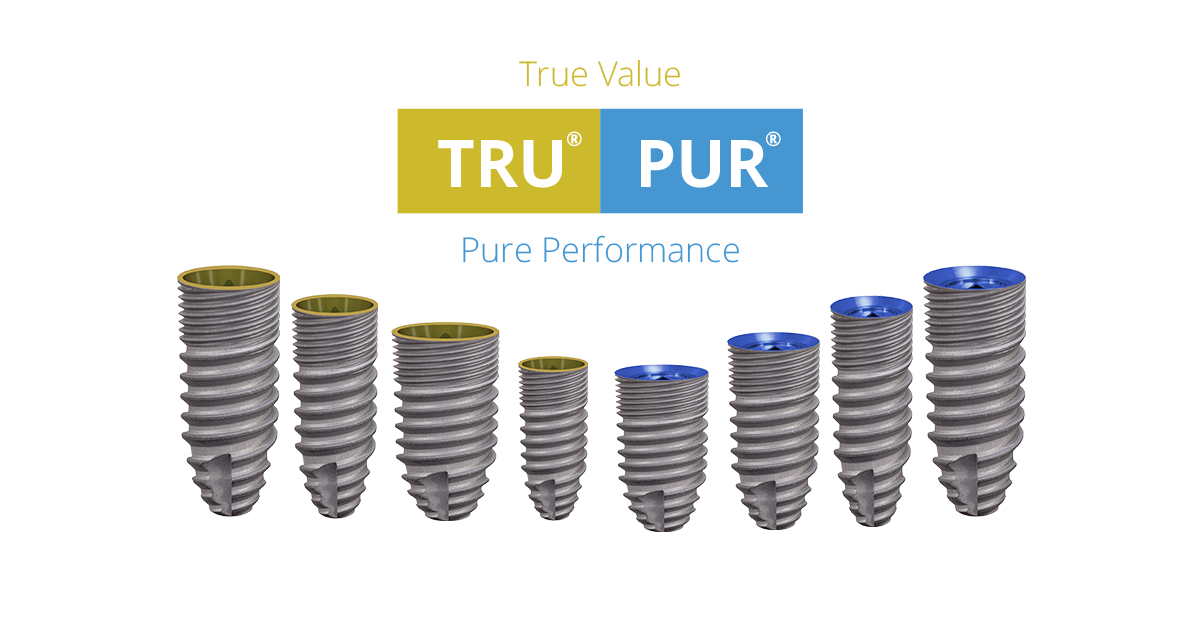The Keys to Implant Success: Technology, Training, and Tenacity
An article titled "The Keys to Implant Success: Technology, Training, and Tenacity", in the latest issue of Dental Product Shopper (Vol. 18 No. 1), dives deep into the essentials of dental implants, opportunities for furthering your implant education and more. We are pleased to share a snippet from the article, featuring our very own TRU and PUR implants.
Combining the right tools with top-notch education unlocks the potential for successful implant procedures that give patients a truly gratifying experience.
A rookie ball player doesn’t win MVP overnight, just as novice actors suffer through stage fright and movie flops before coming a household name. Though never a guarantee, success in any endeavor requires a healthy dose of training and practice, and if you’re lucky, a few good mentors along the way. While many general practitioners are grateful to have mastered their craft, allowing them to provide exceptional everyday dentistry, adding a new treatment to their roster of service can feel as daunting as the first day of dental school.
“I started placing implants in 2007 after taking some basic courses, but it wasn’t until I purchased my own practice 2 years later that I really dove into implantology. My patients loved the results!” said Kaveh Ghaboussi, DMD, who owns Madison Smile Solutions in Madison, WI. “At first, it was just for dental stabilization. These patients had been suffering with dentures for such a long time that literally any solution would have been better. Even though they were happy with the results, I was so nervous doing those first 4 or 5 cases.”
To overcome his anxiety, Dr. Ghaboussi threw himself into hands-on continuing education. He added, “I also had two really great mentors: Dr. Ara Nazarian, who came to my office for hands-on implant training, and Dr. Arun Garg, whose implant continuum includes cadaver and live-patient courses. We were able to Identify existing patients who were missing a tooth or had extractions, flippers, partials, or dentures. All we had to do was talk to them about implants when they were in for their regular appointments. I was surprised that there were so many patients just sitting in my practice who needed and wanted implant therapy—I just needed to look!”
What also surprised him was that many of these implant candidates had been given—but failed to follow up on—referrals to the oral surgeon. “When I asked why they never followed up, these patients told me that it was a hassle for them to make an appointment somewhere else. Allowing them to have implants placed at our office was a great customer service for them.”
The Keys to Implant Success
Dr. Ghaboussi began his implant journey 15 years ago, at a time when few general dentists were placing implants in-house. While he admits being nervous to invest in the process, over time, he identified 3 key areas that dentists should focus on:
- Taking high quality CE so you can feel confident in providing implants to your patients, as well as using technology to make implants a safe, effective, and efficient treatment.
- Choosing the right implant placement kit, motor, and handpiece.
- Using CBDCT imaging to ensure you will achieve an effective and safe result
“Today, it's a much better environment for general dentists who want to begin helping their patients with life changing implant therapy,” he said. “Thanks to pioneers like my mentors, implant placement is now very common among general dentists, and CE is easily available.”
The implant workflow has certainly evolved over the years, with each of Dr. Ghaboussi’s implant cases now beginning with both a CBCT and intraoral scan. “These scans are then used to design and 3D print a surgical guide. I find that when surgical guides are used, the implant process becomes very accurate, predictable, and efficient. This makes me confident that the procedure will be safe for my patients.”
Helping matters, he added, is the fact that CBCT is now the standard of care for imaging in many treatment areas, including implant placement. It's also widely available and can be found at many price points and with a variety of features—making the technology more easily attainable for the average dental practice.
And then, there are implants themselves. “Every implant company has its own placement kit, but before you choose one, I would suggest contacting these manufacturers and finding out what their support is like, Dr. Ghaboussi noted. “Do they have a rep in your area? Do they offer training on their system? Are they going to be there when you have questions or concerns? And, ultimately, are they going to be invested in your success?”
“My belief is that every general dentist has the ability to place implants with the proper training, Dr. Ghaboussi concluded. “I encourage everyone reading this to start on the implant journey it's something you won't regret.”
IMPLANTS
A key feature of Sterngold’s TRU conical hex and PUR internal hex connection implants is that restorative components are conveniently bundled with every implant at a low flat fee. TRU and PUR Implants are substantially equivalent to the leading conical and screw-vent connection implants in the market and available in a wide range of length and diameters. MOR Mini Implants, small-diameter implants ranging from 2.1mm to 3.0 mm, are designed to help clinicians provide an affordable alternative wherever smaller implants make sense.

